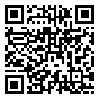BibTeX | RIS | EndNote | Medlars | ProCite | Reference Manager | RefWorks
Send citation to:
URL: http://umj.umsu.ac.ir/article-1-552-en.html
F Eghbalian [1] , MD AR Monsef [2] , MD
Received: 9 June, 2009 Accepted: 30 Aug 2009
Abstract:
Background & Aims: This study was performed to compare the effects and complications of single and double surface photo therapies.
Materials & Methods: This study was done on 80 neonates. Infants in group one and two received single and double surface photo therapies, respectively. Bilirubin level was measured at the beginning of the study, 12 and 24 hours after phototherapy and at the releasing time. The complications of phototherapy such as hypocalcemia, thrombocytopenia, skin rash, and diarrhea were evaluated.
Results: The mean total bilirubin level of single and double surface photo therapy groups at the beginning of therapy were 16.84±1.29 and 20.80±2.38 mg/dl, respectively and 15.00±1.38 and 16.75±2.34 mg/dl respectively after 12 hours of therapy. Serum bilirubin concentration decreased during phototherapy (p=0.000) and there were significant differences between two groups. After 24 hours of therapy the mean total bilirubin levels of single and double surface photo phototherapy group were 12.15±1.70 and 12.81±2.83 mg/dl, respectively. Serum bilirubin concentration decreased during phototherapy and there were significant differences between both groups. There was no significant difference between two groups during hospitalization and bilirubin decreased at releasing time. Skin rash was more frequent in double surface phototherapy group (p<0.05) . No other significant relation between two groups in hospitalization period was found.
Conclusion: Double surface photo therapy was more effective in decreasing bilirubin after 12 and 24 hours but there was no significant difference between two groups in duration of hospitalization, bilirubin decrease at releasing time, and complications of phototherapy.
Keywords: Neonate, Hyperbilirubinemia, Phototherapy
Address: Besat Hospital , Hamadan University of Medical Sciences, Hamadan , Iran . Tel: (+98811) 2640061
Email: eghbalian_fa@yahoo.com
Source: UMJ 2010: 20(4): 329 ISSN: 1027-3727
[1] Associate Professor of Neonatology, Hamadan University of Medical Sciences, Hamadan , Iran (Corresponding Author)
[2] Associate Professor of Pathology, Hamadan University of Medical Sciences, Hamadan , Iran
| Rights and permissions | |
 |
This work is licensed under a Creative Commons Attribution-NonCommercial 4.0 International License. |





